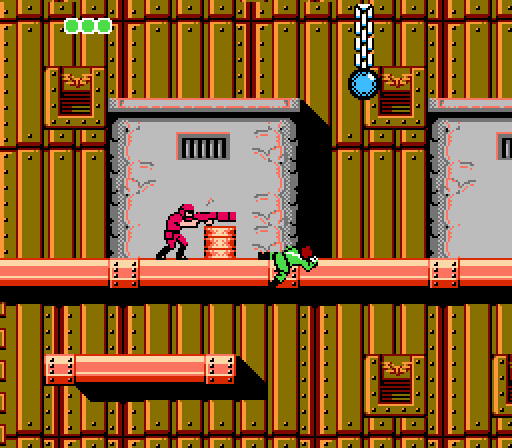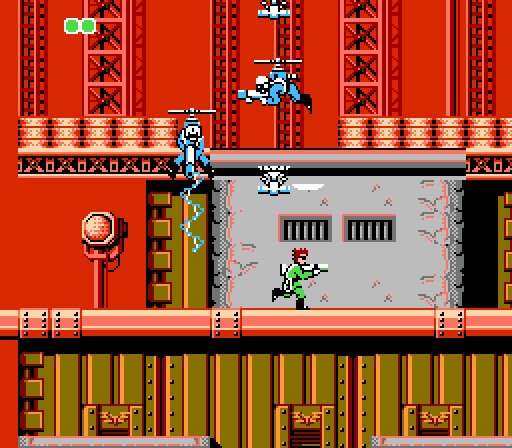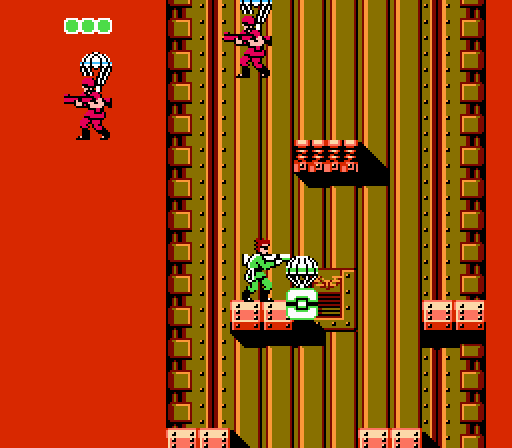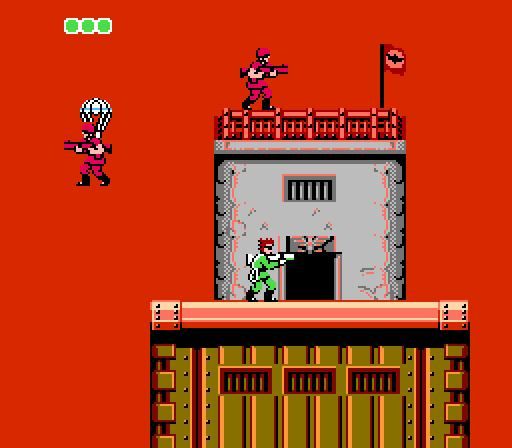I’m as surprised as anyone by just how many parts this Bionic Commando series is turning out to be. I figured by this point I’d be toward the end of the game already, but I’m still working toward the halfway point. Maybe the second half will be much faster, but who knows? I mean, I already loved the game for its complexity, but seeing it in print like this really doubles my appreciation for it. I didn’t even know that was possible.
So here we have Area 5. On the stage map, this appears fairly close to where you begin the game, so in terms of visual information it appears to be a stage you’re meant to go after early on. The numeration tells the true story, though: This is a much more complex and difficult level than Areas 2-4, and it really behooves you to get a handle on some of the game’s advanced mechanics before making this perilous ascent.
Although there’s no fear of falling damage in Bionic Commando, the Area 5 climb can be quite deadly. The stage is so large that Capcom’s designers divided it into three sections, likely as a matter of memory conservation. Each of the three sections, pixel-wise, comprises roughly the same volume as the interior or exterior portions of many other stages. I don’t know how exactly Bionic Commando‘s memory management works, because why would I?, but I would be in no way surprised to learn that the game has a hard limit on the vertical or horizontal resolution of a contiguous area. If that’s the case, Area 5 is so extensive that it exceeds that limit twice. It’s a beast of a stage, and its scale is matched by its difficulty.
Unlike most other stages we’ve seen so far, Area 5 doesn’t really bother with nonlinearity or alternate routes; you have a single task here, and that is to climb. While the route upward presents multiple handholds for your bionic arm at first, you have a single direction to advance, and one way to get there.
This stage really gets into what makes Bionic Commando different from a legion of other platformers: Its verticality. Yes, other platformers allow you to jump, but here you move vertically as both a primary and secondary means of locomotion. We’ve seen that before in portions of Donkey Kong Jr., but unlike the protagonist of that game Captain Spencer is quite capable of moving around on the ground competently, thank you very much. He commands both axes of motion, a real rarity in the genre.
If you actually stop to look at the physical structure of this tower, it’s bizarrely hilarious — a ramshackle mess rising hundreds of feet into the air, with entire segments consisting of bare girders and bunker-like constructs of concrete and steel jutting unevenly from the central mass. It would probably be a lot easier to just fire a bazooka into a load-bearing pillar and bring the stage collapsing down, but alas that video games rarely offer such sensible solutions.
Area 5 begins to introduce a number of new threats and challenges to the combat matrix, as it were. In addition to the usual guys who snipe from behind cover and drifting paratroopers, you’ll also encounter a number of dangers designed specifically to inconvenience you on your ascent rather than simply harm you.
The steel balls in the image above, for example, hang from a chain until you draw near, at which point they break loose and come plummeting toward you. While they cause Captain Spencer some minor physical harm, the real danger they pose is an implacable moving object that advances quickly toward you and which you can’t simply duck, unlike enemy bullets. They force you to react by pulling yourself off the ground — though in doing so you run the risk of exposing yourself to other hazards. Like the snipers behind cover.
In the lowest portion of the tower, you’re forced to learn to use precarious footholds to climb to higher areas. Way back in Area 1, you had to use a searchlight as a grapple point for moving between portions of the stage, but here you begin to find areas where you have to stand atop those searchlights in order to reach the next highest platforms — the trick being that their rounded shape causes you to beginning slipping off immediately. So you have to use your arm again as soon as you scramble to the top of the lamp. The first time you encounter this particular situation, you get to wrestle with it in an area where you can easily clear out all the bad guys and take all the time you need, but further up you won’t encounter such luxuries.
After making a fairly impressive climb, you’ll finally reach a communication room door at a point at which the screen stops scrolling upward. You need to activate the comm array in order to advance here — not to open the boss door, but to open the second comm room overhead. When you step out of the communication room, the lower portion of the tower becomes inaccessible, and the second portion of the area sprawls above.
This sequence is much more challenging than the last, because you face entirely new challenges new to this stage. Mounted on the ceilings you’ll find sprinkler-like devices that fire off an energy beam every few seconds. The beam is narrow and flies along parallel to the ceiling, so it wouldn’t seem to be particularly threatening. However, it has the ability to sever your grappling arm’s hold on the ceiling, so unless you have a weapon capable of destroying the emplacement you’ll have to time your climbs carefully lest you find yourself constantly knocked back down.
Supplementing these nuisances you’ll encounter an endlessly spawning array of heli-pack troops who hover around and harass you as you try to climb between laser emissions. These soldiers putter around in midair for a while before locking into a fixed vertical position and strafing across the screen. As they strafe, they fire an electrical beam that always seems to be just about the right height to smack Captain Spencer in the head. You can duck beneath them, of course, but at the same time you’re trying to climb to new heights between devices whose sole purpose is to prevent you from doing so. And there’s no end to these hovering menaces, so you can’t simply clear them away before advancing. Eventually, you just have to go for it.
As a new element of risk in this stage, you can’t allow yourself to be knocked off the side of the tower. On the lower level it didn’t matter so much, but here in this sequence and the one above the screen will no longer scroll all the way back down to the bottom. If you fall off the side, you’ll die — though perhaps that’s a mercy versus being forced to make a three-section climb all over again.
Beyond the second communication door, the screen locks into the uppermost portion of the tower, and the tower itself narrows. The dangers of the middle portion — the grip-smashers, the hovering soldiers — retire in favor of a much simpler challenge: Paratroopers. However, the new challenge here comes in the constricted space in which you can maneuver. The tower at this point only spans half the screen, and there are no more wide platforms to traverse, only small blocks that you must navigate one by one. If you overshoot with your swings, you’ll quite possibly go sailing over the edge and fall to your death.
Because the paratroopers spawn infinitely, you need to take care with your climb; it’s entirely too easy to swing into a soldier and be knocked down to the lower levels (or worse). An added element of complexity comes from the plug-like objects in the upper-middle portion of the image above. They work as springs or air fans or something; whatever the case, they send you shooting upward in an arc as soon as you climb onto them. They’re sort of a spiritual counterpart of the spotlights in that you can’t stand on them, but you’re thrust upward rather than down. The springs are essential to reaching distant platforms, but it’s important that you understand their mechanics — that is, which way they’ll send you flying when you mount them. These springs have appeared in previous stages in a not-particularly-noteworthy fashion, but here they serve as an integral element of the level design and demand mastery.
But should you finally reach the top, congratulations! You’ve done something remarkable. Your reward is the best weapon in the game, guarded by one of those laughable robots from Area 3.




This, I thought, is where the game gets really hard. Especially those heli-pack troops are a real nuisance, and I needed at least ten attempts (thank the lord for those continue pickups) to get it right.
Your observation is excellent, by the way, that BC is a remarkably vertical platformer. On the other hand, I disagree that Capt. Spencer is locomotively competent. A grown-up man who cannot jump??? He IS white, but still…
This was my favorite level. I also liked the music and color palette, it gave the level a melancholy feeling.
It’s been a while since I played, but I’m fairly sure that you don’t even have to use the coms in the com rooms, you just have to walk in and out of the door for the next section to load. (Of course, you may still want to do it at least once to read the messages)
Right, but you need to have possession of the correct receiver in order for the doors to open.